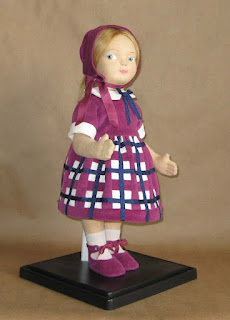Carina is a reproduction of a 1920's molded felt doll, made by the Italian firm of Lenci. The Lenci company was begun in Turin, Italy in 1919 by Elena Konig Scavini,
whose nickname was Lenci. Lenci dolls
are made of felt, with pressed felt faces that were usually then oil
painted. The dolls became very popular
in the 1920’s and 1930’s. In 1939,
Madame Lenci sold her company to her director, Garella. Many of the dolls made by Lenci represented
children, some made with pouty faces.
Usually, the eyes were glancing to the side, which has become known on
the American market as “flirty eyes.”
Other dolls made by Lenci represented adults, some representing historic
or living people, others representing a variety of nationalities.
Feltpro (www.feltpro.net) sells a kit for making a reproduction Lenci
doll. The picture at the left is from
their website, and shows two of their reproduction Lenci dolls. The bodies are made of felt that is sewn
together and stuffed. The arms and legs
are jointed, and the head swivels. The
face is made of pressed felt, which is sewn to the head back and the whole is
stuffed. The face is then painted and a
wig applied.
The photo at the left is the Lenci that I made from a Feltpro kit. (This picture was taken with my old,
on-its-last-legs camera.) Making the
doll was definitely a learning experience! As can be seen in
the photo, my Lenci turned out to be quite a bit plumper in the midsection than the photo from the Feltpro website. When
they say to stuff the doll firmly, I stuff firmly!
At the left is a sketch of a doll from the 1927 Lenci catalog, whose
outfit I chose to replicate. This
outfit, as many of the Lenci doll clothing, was made from felt. The plaid skirt fabric was made by piecing
together felt squares and rectangles. I
tried to find felt thin enough to piece together, but was unsuccessful. In addition, my doll, standing at 15 inches
tall, is considerably shorter than the original Lenci dolls, and that may have
been a factor. So I decided to use
cotton velveteen, which was as close to looking like felt as I could get and
still be able to use the same construction techniques as in the original
clothing.
Here is my finished Lenci reproduction.
The white and magenta velveteens are from Farmhouse Fabrics. The skirt is pieced together from squares of
white velveteen and bands of magenta, and then navy blue soutache is stitched
on top to make the plaid fabric. It
looks as if the vertical bands of magenta get narrower toward the top, but they
do not. The effect is due to the skirt
being gathered onto the bodice, which pulls in the tops of those vertical
bands. The collar and sleeve cuffs are
made from the white velveteen, and the blue bow at the neckline is made from
the soutache. The shoes are modeled after those made for the original Lenci dolls. They are made from the same magenta velveteen
as the dress. The ribbon ties for the
shoes and for the bonnet are hand-dyed silk ribbons. The bonnet is modeled after those worn by many
Lenci dolls. The doll in the sketch that
I replicated did not have a bonnet, but my doll’s hair was a bit unruly and I
thought a bonnet would help.
Here is a close-up of my Lenci reproduction’s face. I named her Carina. Cara
means “dear” or “beloved” in Italian; Carina
thus means “little dear.” I do think
that this doll is a little dear, so the name fits.





No comments:
Post a Comment